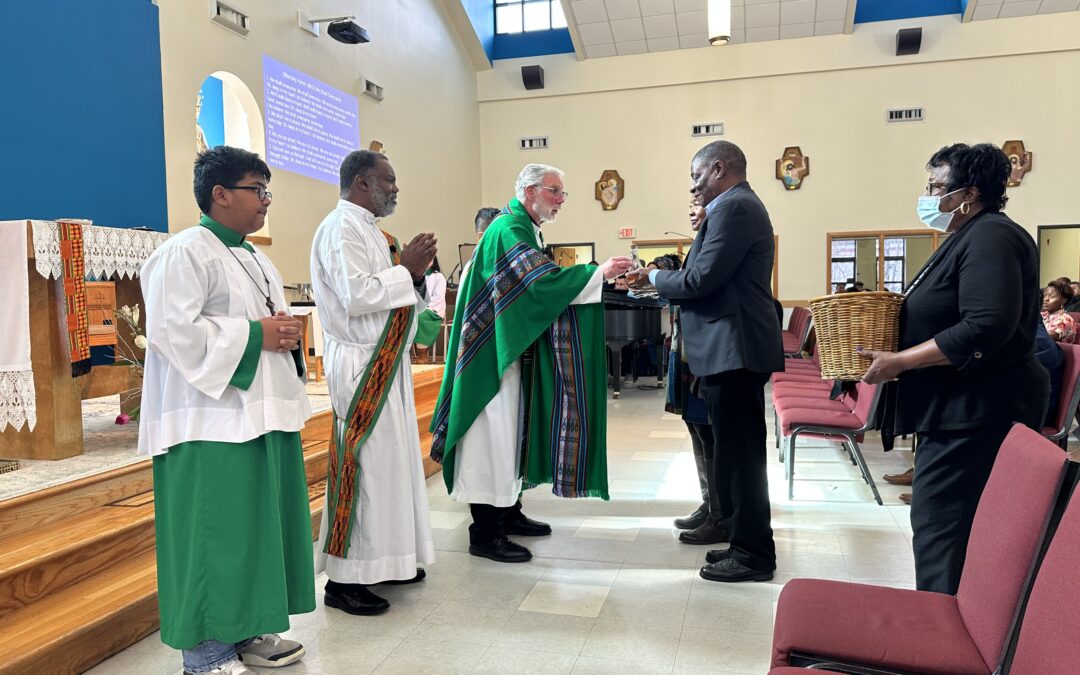In the late 1920s, Greensboro, North Carolina, was still a relatively small city with approximately 50,000 residents, a mere fraction of its current population of 370,000. However, during that time, Greensboro consisted of two separate and conflicting worlds. Unsurprisingly, the spiritual communities reflected these racial and ethnic divisions. Consequently, this segregation precipitated the founding of St. Mary’s Catholic Church in 1928, located east of downtown Greensboro.
The Vincentians of the Eastern Province have ministered to St. Mary’s since its early years. Today, longstanding and recent parishioners universally credit the Vincentians’ spiritual guidance and humanitarian support for fostering harmony in their community amid its historical challenges—a one-world outlook inspired by faith, even as the ethnic and cultural makeup of Greensboro diversifies through continuous waves of immigration.
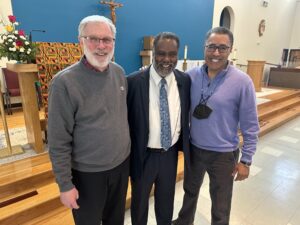
(Left to right): Fr. John Timlin, CM, pastor of St. Mary’s; Deacon James Mahoney, Associate Director, The Basilica Shrine; and Michael Diamond, Chair, St. Mary’s Pastoral Council.
“There have been some dramatic changes over time, some of which I’m very proud of and some of which have resulted in us experiencing growing pains,” admits Michael Diamond, chair of St. Mary’s Pastoral Council. “The church has gotten much, much bigger, particularly as we open our arms to embrace immigrant populations.”
Today, migrants continue to file into the United States seeking asylum, work, and better lives for their families. One such group is the indigenous Vietnamese, who identify as Montagnard, a French term meaning “mountain people.” Facing persecution in their war-torn homeland, the Montagnard arrived in Greensboro in the 1970s and 1980s and joined the parish. St. Mary’s has also experienced an influx of African populations, many of whom come to study or teach at local universities. Additionally, a large and vibrant group of Latin Americans have settled in Greensboro in search of better employment opportunities in and around the rapidly growing city.
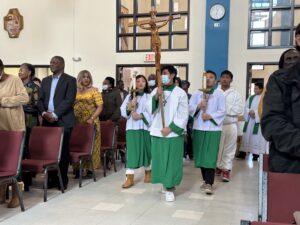
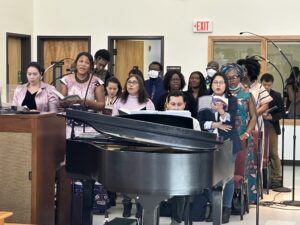 Opening Mass Processional includes young church members of myriad ethnicities. A diverse choir leads the congregation during Mass at St. Mary’s.
Opening Mass Processional includes young church members of myriad ethnicities. A diverse choir leads the congregation during Mass at St. Mary’s.
“This church was one of the smallest and probably had the least resources to accommodate that arrival of people,” says Diamond. “But given our history with the African American community, we can relate to folks who are in distress and transition. We can relate to folks who are trying to establish themselves and get off the ground. And this was the church that welcomed and embraced them.”
Historically, the members of St. Mary’s have faced challenges based on their religious identity. Protestant denominations dominate the landscape, as is prevalent in much of the South, which has large populations of Baptists, Methodists, Presbyterians, and Quakers. For most of the 1920s, there were two Catholic churches in town (Our Lady of Grace on the west side and St. Benedict on the north side), recalls Virginia A. Smith, who was baptized at St. Mary’s in 1937, and is the longtime parish historian. Both parishes consisted of white members only.
“They didn’t have a Catholic church that we could attend,” Smith recalls.
One of the young parish’s most impactful ministries was a co-educational grade school run by another Vincentian religious community, the Daughters of Charity. The school was small in every sense of the word with each classroom serving multiple grades and with graduating classes sometimes numbering in single digits. Yet, it offered high-quality academics and religious education that appealed to families of diverse economic means, even non-Catholics.
Geraldine Tyler Johnson was being raised Baptist when her family moved into a home across the street from St. Mary’s.
“We lived on the other side of Duke Street, and my dad moved us there because he wanted us to go to Catholic school,” explains Tyler Johnson. “He met someone who was sending his daughters [to St. Mary’s], and he told my dad about the school.”
Despite attracting affluent families, the school didn’t turn away families in need even if they couldn’t afford the tuition.
Frances Bradshaw grew up in a family of 10 children, where money was very tight.
“They still educated us. They still treated us the same,” she recalls. “We were poor, but we didn’t know it. Our education did not suffer [because of] that.”
“The Daughters of Charity are beloved [at St. Mary’s] because they conducted the school and told the children they were as good as anybody else, no matter what anyone else said,” explains Fr. John P. Timlin, CM, who has served two tenures as pastor at St. Mary’s.
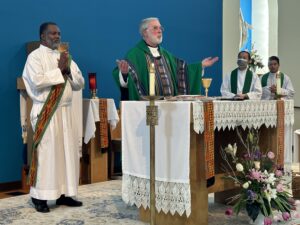
Deacon Mahoney assists Fr. Timlin at Mass during Black History month in February 2023.
Many older members also recall how St. Mary’s helped elevate marginalized communities during the American Civil Rights movement. The church was a gathering point for many marches and sit-ins that attracted local activists from out-of-state, parishioner Gloria Bauman recalls.
Even today, honoring and celebrating the heritage of the parish and its multi-culturalism is central to its liturgical and pastoral ministries. Regular Masses are held in English, Spanish, and the Vietnamese language of the Montagnard. Though the various cultural groups have separate services, they support each other and learn from one another.
When the church celebrates Black History Month every February, members from all the contingents participate. One year, members produced a dramatization of the life of Augustus Tolton, who is recognized as the first Black Catholic priest in the United States. Another year, they staged a fictional conversation between the Rev. Dr. Martin Luther King III and Malcolm X. Earlier this year, the church’s Black Catholic Committee decided to pay special tribute to the earliest members of the congregation—the church elders.
“Our roots are in the Black Catholic community and it was the Black Catholic community who welcomed the first wave of immigrants with open arms into St. Mary’s,” Fr. Timlin explains. “And in the Black community, the elders are the wisdom figures. They are highly respected. I know; I have experienced their wisdom. They persevered. They made St. Mary’s a place of worship and a place of justice—and a place that would speak out against injustice.”

